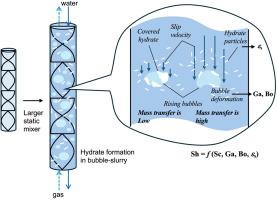静态混合器垂直管反应器分离氢基HFC134a气体的传质过程
IF 3.9
3区 工程技术
Q3 ENERGY & FUELS
Chemical Engineering and Processing - Process Intensification
Pub Date : 2025-10-01
DOI:10.1016/j.cep.2025.110573
引用次数: 0
摘要
水合物基气体分离因其材料成本低、环境成本低而受到温室气体回收的关注。我们以前曾建议使用静态混合器进行水合物基气体分离的连续操作。为了优化该工艺,必须调节水合物的形成和分解速率,回收水合物浆体产生的气体,并确定最佳反应器设计和操作条件。在实际过程中,水合物的形成往往是复杂的,因为气相、液相和固相对总体传质有各种各样的影响。在这项研究中,水合物形成过程中的传质研究使用了一个带有静态混合器的垂直管式反应器,其内径比之前的研究(11 mm)大两倍(23 mm)。值得注意的是,反应器中水合物浆体中存在许多微小气泡(直径为2mm),阻碍了水合物的传质。在对气泡柱中其他气液传质系数进行关联的基础上,采用无因次数确定了气泡-水合物浆体中水合物形成传质系数的关联方程。在水合物形成过程中,气泡变形、振荡和水合物颗粒有利于表面传质。结果表明,水合物颗粒在气泡表面的吸附抑制了气泡的变形和振荡。本文章由计算机程序翻译,如有差异,请以英文原文为准。

Mass transfer during hydrate-based HFC134a gas separation using a vertical pipe reactor with a static mixer
Hydrate-based gas separation has attracted attention for the recovery of greenhouse gases because of its low material and environmental costs. We have previously proposed the use of a static mixer for the continuous operation of hydrate-based gas separation. To optimize the process, it is essential to regulate the hydrate formation and decomposition rates, recover the gas generated from the hydrate slurry, and determine the optimal reactor design and operating conditions. Hydrate formation in practical processes is often complex because the gas, liquid, and solid phases have various influences on the overall mass transfer. In this study, mass transfer during hydrate formation was investigated using a vertical pipe reactor with a static mixer containing an inner diameter that was two times larger (23 mm) than that of the previous study (11 mm). Notably, many tiny bubbles (< 2 mm in diameter) were observed in the hydrate slurry in the reactor, which hindered the mass transfer of hydrates. The correlation equation for the mass transfer coefficients obtained during hydrate formation in the bubble-hydrate slurry was determined using dimensionless numbers, based on the correlation determined for other gas-liquid mass transfer coefficients in bubble columns. Bubble deformation, oscillation, and hydrate particles facilitated superficial mass transfer during hydrate formation. The results suggest that bubble deformation and oscillation were inhibited by the adsorption of hydrate particles on the bubble surfaces.
求助全文
通过发布文献求助,成功后即可免费获取论文全文。
去求助
来源期刊
CiteScore
7.80
自引率
9.30%
发文量
408
审稿时长
49 days
期刊介绍:
Chemical Engineering and Processing: Process Intensification is intended for practicing researchers in industry and academia, working in the field of Process Engineering and related to the subject of Process Intensification.Articles published in the Journal demonstrate how novel discoveries, developments and theories in the field of Process Engineering and in particular Process Intensification may be used for analysis and design of innovative equipment and processing methods with substantially improved sustainability, efficiency and environmental performance.

 求助内容:
求助内容: 应助结果提醒方式:
应助结果提醒方式:


